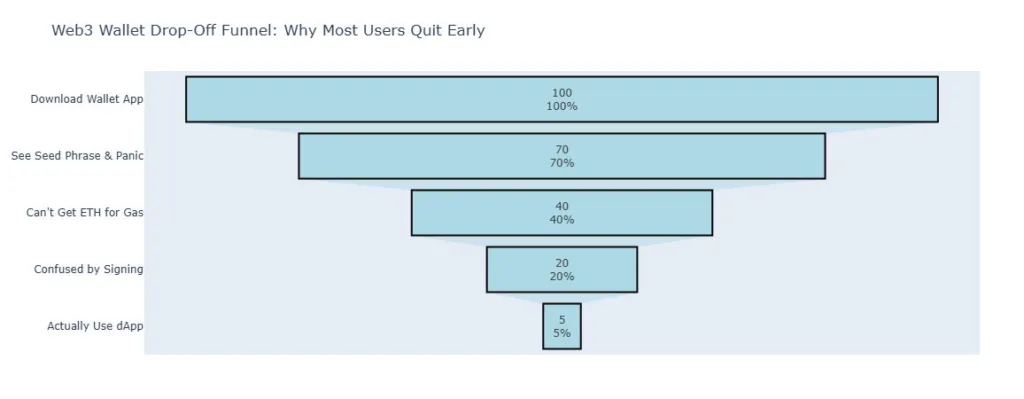-
Account Abstraction eliminates the need for seed phrases, making Web3 wallets as easy to use as Web2 apps.
-
Gas fees can now be paid in any token — or even covered by the app — simplifying onboarding for everyone.
-
Smart wallets powered by Account Abstraction enable social recovery, 2FA, and seamless multi-step transactions.
As the crypto industry continues to grow, one critical question remains unanswered: how can we onboard the next billion users? While the technology behind blockchain has evolved rapidly, user experience has lagged behind. Wallet creation, seed phrase management, gas fees, and complex transaction flows remain significant barriers to mass adoption. One solution is gaining traction across the Ethereum ecosystem and beyond — Account Abstraction (AA).
Account abstraction promises to bridge the gap between the technical foundation of Web3 and the user-friendly experience people expect from modern apps. By making wallets smarter, safer, and more intuitive, account abstraction can radically reshape how users interact with blockchain — and in doing so, bring crypto to the masses.

What Is Account Abstraction?
In the traditional Ethereum setup, there are two types of accounts: Externally Owned Accounts (EOAs), controlled by a private key (like MetaMask wallets), and contract accounts, which are smart contracts deployed on-chain. EOAs can initiate transactions, while contract accounts can only respond to them. This distinction limits user flexibility and forces most wallets to rely on outdated mechanisms like seed phrases and strict key management.
Newsletter
Get weekly updates on the newest crypto stories, case studies and tips right in your mailbox.
Account abstraction removes this separation by allowing smart contracts to act as wallets, giving them the power to initiate transactions and define custom logic for verification, payment, and security. In essence, a wallet becomes programmable. Users can create and use wallets with tailored rules, like requiring two-factor authentication, social recovery, or even daily spending limits — all governed by smart contract code.Ethereum’s path to this vision is formalized through ERC-4337, a standard that implements account abstraction without requiring core changes to the Ethereum protocol. Many Layer 2 networks such as zkSync, Starknet, and Polygon are also embracing native account abstraction features.

Why the current wallet experience is a problem
Web3 wallets are still too difficult for most people to use. The moment a new user downloads a wallet, they’re met with a string of 12 or 24 words and a warning that losing them means losing access forever. It’s a frightening proposition, especially for those who are not tech-savvy.
Once they’re past the seed phrase, users then face gas fees — often requiring ETH to pay for actions on Ethereum, even if they’re using another token or app. They’re also asked to sign confusing transaction messages, without really understanding what they’re approving. These pain points prevent regular people from exploring decentralized finance (DeFi), NFTs, or on-chain games.If Web3 is to truly become mainstream, it must offer the same level of simplicity that Web2 platforms like Google, Instagram, and PayPal provide. That’s exactly what account abstraction makes possible.

Visualized using Python based on Ethereum Foundation UX Research (2023).
How Account Abstraction can onboard the next billion
By transforming wallets into smart contracts, account abstraction allows developers to build experiences that feel familiar, safe, and effortless — without compromising on decentralization.
First, users no longer need to manage a seed phrase. A wallet can be tied to a fingerprint, a face ID, a passcode, or a social login. And if the device is lost, recovery can be handled by trusted guardians (friends, devices, or even institutions) — a system known as social recovery.
Second, gas fees become flexible. With AA, transactions can be sponsored by third parties (like the app itself), or users can pay in any token, not just ETH. This removes a major source of confusion and failure in onboarding.
Third, security becomes programmable. You can require multi-factor approval, set session rules (like “allow all transactions for 15 minutes”), or add daily spending limits. Wallets can also block suspicious behavior automatically — all enforced by smart contract code.
Finally, complex dApp interactions can be bundled into a single transaction. For example, joining a DAO, buying tokens, and casting a vote can all be executed at once. This reduces friction and makes workflows seamless.
All of these enhancements are possible without users needing to know they’re interacting with a blockchain. That’s the real power of account abstraction: it makes Web3 invisible.
Real-world use cases and momentum
Several projects are already putting AA into action. Safe (formerly Gnosis Safe) allows users to create multi-signature wallets and social recovery mechanisms. Stackup and Biconomy offer infrastructure for gasless transactions. zkSync and Starknet natively support account abstraction, offering developers more flexibility than ever before.
Gaming and social applications will benefit massively from this evolution. Imagine signing up for a blockchain-based game using just your email and jumping straight into gameplay without downloading MetaMask or buying ETH. Imagine sending money cross-border with a few clicks, just like a mobile banking app — but on-chain.
Developers are no longer forced to choose between security and simplicity. With AA, they can design user journeys that onboard people in seconds while still offering the full power and ownership of decentralized systems.
The road ahead
While the infrastructure is maturing, account abstraction is still early in terms of adoption. Education, standards, and cross-chain compatibility will be key to unlocking its full potential. Wallet providers, dApp developers, and ecosystem builders must prioritize onboarding design and usability, not just scalability and performance.
But the direction is clear. Just as smartphones abstracted away the complexity of the internet and enabled billions to come online, account abstraction can do the same for Web3.













